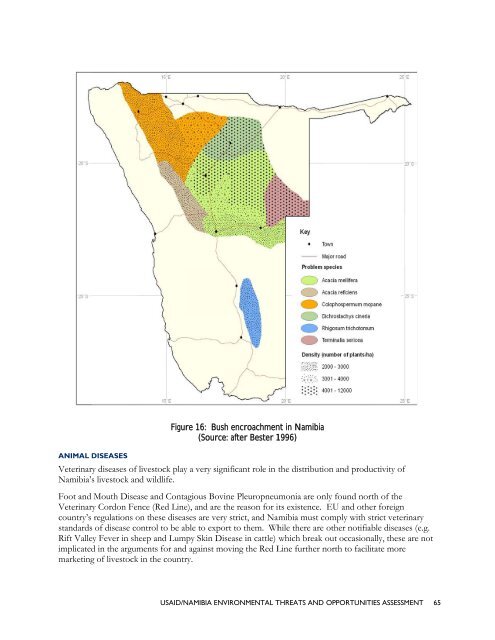usaid/nambia environmental threats and opportunities assessment
usaid/nambia environmental threats and opportunities assessment
usaid/nambia environmental threats and opportunities assessment
You also want an ePaper? Increase the reach of your titles
YUMPU automatically turns print PDFs into web optimized ePapers that Google loves.
Figure 16: Bush encroachmen<br />
nt in Namibia ia<br />
(Source: after Bester r 1996)<br />
ANIMAL DISEASES<br />
Veterinary<br />
diseases of livestock play<br />
a very significant role in the distribution <strong>and</strong> productivity of<br />
Namibia’s<br />
livestock <strong>and</strong> wildlife.<br />
Foot <strong>and</strong> Mouth Disease <strong>and</strong> Contagious Bovine<br />
Pleuropneumonia are only found north of the<br />
Veterinary<br />
Cordon Fence (Red Line), <strong>and</strong> are the<br />
reason for its existence. EU <strong>and</strong> other foreign<br />
country’s regulations on these diseases are very strict, <strong>and</strong> Namibia must comply with strict veterinary<br />
st<strong>and</strong>ards of disease control to be able to export<br />
to them. While there are other notifiable diseases (e.g.<br />
Rift Valley Fever in sheep <strong>and</strong> Lumpy Skin Disease in cattle) which break out occasionally, these are<br />
not<br />
implicated<br />
in the arguments for <strong>and</strong><br />
against moving the Red Line further north to facilitate more<br />
marketing<br />
of livestock in the country.<br />
USAID/NAMIBIA ENVIRONMENTAL THREATS AND OPPORTUNITIES ASSESSMENT 65

















